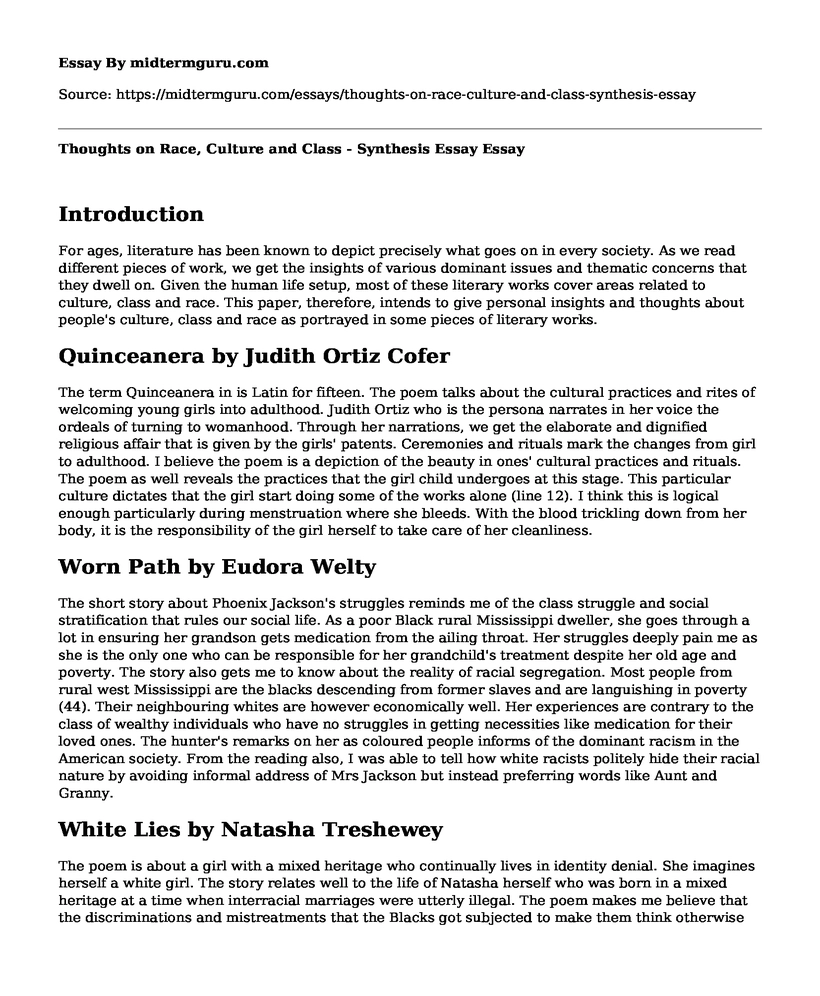Introduction
For ages, literature has been known to depict precisely what goes on in every society. As we read different pieces of work, we get the insights of various dominant issues and thematic concerns that they dwell on. Given the human life setup, most of these literary works cover areas related to culture, class and race. This paper, therefore, intends to give personal insights and thoughts about people's culture, class and race as portrayed in some pieces of literary works.
Quinceanera by Judith Ortiz Cofer
The term Quinceanera in is Latin for fifteen. The poem talks about the cultural practices and rites of welcoming young girls into adulthood. Judith Ortiz who is the persona narrates in her voice the ordeals of turning to womanhood. Through her narrations, we get the elaborate and dignified religious affair that is given by the girls' patents. Ceremonies and rituals mark the changes from girl to adulthood. I believe the poem is a depiction of the beauty in ones' cultural practices and rituals. The poem as well reveals the practices that the girl child undergoes at this stage. This particular culture dictates that the girl start doing some of the works alone (line 12). I think this is logical enough particularly during menstruation where she bleeds. With the blood trickling down from her body, it is the responsibility of the girl herself to take care of her cleanliness.
Worn Path by Eudora Welty
The short story about Phoenix Jackson's struggles reminds me of the class struggle and social stratification that rules our social life. As a poor Black rural Mississippi dweller, she goes through a lot in ensuring her grandson gets medication from the ailing throat. Her struggles deeply pain me as she is the only one who can be responsible for her grandchild's treatment despite her old age and poverty. The story also gets me to know about the reality of racial segregation. Most people from rural west Mississippi are the blacks descending from former slaves and are languishing in poverty (44). Their neighbouring whites are however economically well. Her experiences are contrary to the class of wealthy individuals who have no struggles in getting necessities like medication for their loved ones. The hunter's remarks on her as coloured people informs of the dominant racism in the American society. From the reading also, I was able to tell how white racists politely hide their racial nature by avoiding informal address of Mrs Jackson but instead preferring words like Aunt and Granny.
White Lies by Natasha Treshewey
The poem is about a girl with a mixed heritage who continually lives in identity denial. She imagines herself a white girl. The story relates well to the life of Natasha herself who was born in a mixed heritage at a time when interracial marriages were utterly illegal. The poem makes me believe that the discriminations and mistreatments that the Blacks got subjected to make them think otherwise of their heritage. Like Natasha, some think being black is a complete curse. I learnt that many times, black people would imagine themselves integrating and shopping in white places. Some would lie that they live in White's hoods (Stanza 2).
“This Is What It Means to Say Phoenix, Arizona” by Sherman Alexie
The story revolves around Victor and his predicaments. His Indian name completely lands him into problems (8). The story teaches me that being non-Native American can make you lose your job. Poverty and sufferings in this society are also highly linked to non-natives. This story makes me believe that in this society, non-Americans have to strive so hard for their respect and dignity.
I, Too, Sing America by Langston Hughes
I believe the story gives me deep insights into positivity and insights over one's race no matter what. The black man is sent to eat in the kitchen when the visitors come, but he laughs off (Stanza 1). I come to know about the fantastic self-esteem that some individuals who are racially segregated and discriminated develop. Through the story, I learn that one can live positively and try to change the people around them on their racial prejudices.
Conclusion
Even though these pieces of works belong to varied genres in different settings, they discuss relatively similar thematic concerns. They revolve around race, culture and class. When carefully read and internalised, they grant one with the opportunity to learn how people of diverse cultures, heritages, classes and races relate and views each other. One is hence hinted and tipped on how to best survive as per the situations or what to do and improve on the current situation especially in the multicultural setup.
Works Cited
Trethewey, Natasha. "White Lies." Domestic Work (2000).
Hughes, Langston. "I, too, sing America." The poetry of the Negro (1970): 1746-1970.
Alexie, Sherman. "This is what it means to say Phoenix, Arizona." The Lone Ranger and Tonto Fistfight in Heaven(1993): 59-75.
Stavans, Ilan, ed. Quinceanera. ABC-CLIO, 2010.
Prenshaw, Peggy W., ed. Eudora Welty: Thirteen Essays. Vol. 20. No. 4. Univ. Press of Mississippi, 1983.
Cite this page
Thoughts on Race, Culture and Class - Synthesis Essay. (2022, Sep 25). Retrieved from https://midtermguru.com/essays/thoughts-on-race-culture-and-class-synthesis-essay
If you are the original author of this essay and no longer wish to have it published on the midtermguru.com website, please click below to request its removal:
- Paper Example on South Asian American Communities
- Why I Desire To Be an Alpha Man - Essay Sample
- Genetics Determines Human Behavior - Essay Sample
- "Social Class in America" and "The Working Poor" Reading Response
- Developing Personal Qualities: Initiating Communication & Relationship Management - Essay Sample
- Newborns: Born With Social Skills to Connect and Thrive - Essay Sample
- Police-Community Partnership: Exploring the Impact of Cultural Diversity - Essay Sample







